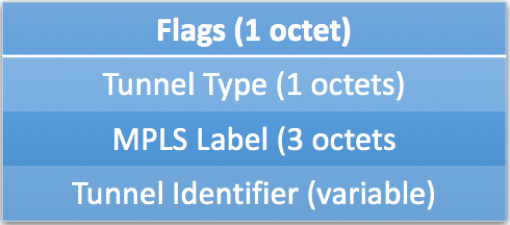Type 3 routes are required for Broadcast, Unknown Unicast and Multicast (BUM) traffic delivery across EVPN networks. Type 3 advertisements provide information about P-tunnels that should be used to send BUM traffic.
Without Type 3 advertisements, ingress router would not know how to deliver BUM traffic to other PE devices that comprise given EVPN instance.
The format of Type 3 advertisement is as follows:

RFC allows for both ingress replication and network-based point-to-multipoint replication as defined in RFC 7117.
Type 3 route must also carry a Provider Multicast Service Interface (PMSI) Tunnel attribute as specified in RFC 6514.

At the moment, only one Flag is defined – Leaf Information Required (L).
The following Tunnel Types are defined, although your vendor might only support a subset of tunnel types:
- 0 – No tunnel information present
- 1 – RSVP-TE P2MP LSP
- 2 – mLDP P2MP LSP
- 3 – PIM-SSM Tree
- 4 – PIM-SM Tree
- 5 – BIDIR-PIM Tree
- 6 – Ingress Replication
- 7 – mLDP MP2MP LSP
Let’s review Type 3 advertisements originated by PE5 in the following example:

The following Wireshark capture demonstrates PE5’s advertisement of Type 3 route:
Path Attribute - PMSI_TUNNEL_ATTRIBUTE Flags: 0xc0, Optional, Transitive: Optional, Transitive, Complete Type Code: PMSI_TUNNEL_ATTRIBUTE (22) Length: 9 Flags: 0 Tunnel Type: Ingress Replication (6) 0100 1001 0011 0110 0000 .... = MPLS Label: 299872 Tunnel ID: tunnel end point -> 120.0.2.5 Path Attribute - MP_REACH_NLRI Flags: 0x90, Optional, Length: Optional, Non-transitive, Complete, Extended Length Type Code: MP_REACH_NLRI (14) Length: 28 Address family identifier (AFI): Layer-2 VPN (25) Subsequent address family identifier (SAFI): EVPN (70) Next hop network address (4 bytes) Number of Subnetwork points of attachment (SNPA): 0 Network layer reachability information (19 bytes) EVPN NLRI: Inclusive Multicast Route AFI: Inclusive Multicast Route (3) Length: 17 Route Distinguisher: 0001780002050064 (120.0.2.5:100) Ethernet Tag ID: 100 IP Address Length: 32 IPv4 address: 120.0.2.5 * 3:120.0.2.1:100::100::120.0.2.1/304 IM (1 entry, 1 announced) BGP group IBGP-RR type Internal Route Distinguisher: 120.0.2.1:100 Route Label: 299872 PMSI: Flags 0x0: Label 299872: Type INGRESS-REPLICATION 120.0.2.1 Nexthop: Self Flags: Nexthop Change Localpref: 100 AS path: [100] I Communities: target:100:100 PMSI: Flags 0x0: Label 299872: Type INGRESS-REPLICATION 120.0.2.1
Advertised Type 3 route as observed on PE5:
root@PE5> show route advertising-protocol bgp 120.0.1.1 extensive * 3:120.0.2.5:100::100::120.0.2.5/304 IM (1 entry, 1 announced) BGP group IBGP-RR type Internal Route Distinguisher: 120.0.2.5:100 Route Label: 315248 PMSI: Flags 0x0: Label 315248: Type INGRESS-REPLICATION 120.0.2.5 Nexthop: Self Flags: Nexthop Change Localpref: 100 AS path: [100] I Communities: target:100:100 PMSI: Flags 0x0: Label 315248: Type INGRESS-REPLICATION 120.0.2.5
Control Plane Wireshark capture can be downloaded from GitHub:
For more information on EVPN, please refer to our other articles on this topic:
